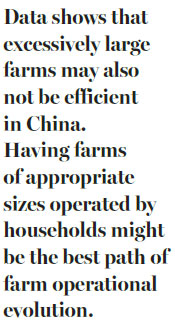Nurturing fair and efficient reform

Strategy of not too big and not too small is the proper way forward for Chinese agriculture
Chinese land reform policy aims to achieve two goals simultaneously - equity and efficiency. Unlike radical land privatization, the core policy in China is to combine collective "ownership" of land, overseen by local village committees, with land use contracts held by individual households. Villagers can lease their lands to more efficient farms while still protecting their contract rights to the land.
For many farm households, even those who have migrated for work in cities, the family plot serves as an ultimate safety net. China now has more than 230 million rural households that hold contract rights to their plots.
Given the unequal land distribution and its social consequences during more than 2,000 years of feudal society in China, the country's leaders believe that private land ownership does not necessarily enrich farmers. Before 1949, a large population of poor, landless peasants was dominated by a small class of landlords. No one wants to risk going back to that.
In some countries, such as India or the Philippines, private land ownership has resulted in slums of unemployed people in the cities and poor farm workers or sharecroppers in the countryside. In some places, society remains almost feudal. Though large farms exist in those countries, they are not always efficient.
Beginning with the breakup of collective farms that started in 1978, the household responsibility system raised agricultural productivity and ensured adequate food supplies for China. Together with an equitable distribution of land, this resulted in a massive reduction in rural poverty in the early reform period. The average annual growth rate of China's agricultural production reached 4.5 percent during the period of 1980-2015, which was more than four times its population growth rate over the same period.

China has made a series of legal and policy efforts to ensure the security of land contract rights for farmers. In 1998, the land contract period was extended to 30 years. Laws issued in the early 2000s prohibited land re-allocation for almost all reasons. In recent years, there have been frequent announcements that land contract rights will not be changed in the long run, implying that plots can be inherited.
The most recent effort involves registering and certifying farmland for each rural household. In conjunction with newly widespread town or county-level land transfer service centers, this has allowed more market-based leasing, not just the earlier transfers among relatives and friends.
Average farm size has been declining in almost every Asian country. China, with an average farm size of less than 1 hectare and nearly 40 percent of the world's small farms, also saw farm sizes falling until the early 2000s. But, for the past 10 to 15 years, China has been using market processes combined with policy support and its unique leasing institutions to move toward larger farms.
The rapid emergence of middle (a few hectares) and large (tens and hundreds of hectares) operational units in many regions of China is striking. By the end of 2013, nearly 53 million, or 23 percent, of rural households had rented out their cultivated land. In the grain growing regions of northern and northeastern China, average farm size increased from 1.03 hectares in 2008 to 1.73 in 2013, a rise of nearly 70 percent in five years. All indicators are that the process has accelerated in recent years.
Policy support for the larger farms includes subsidies for loans, investment or purchases of machinery and insurance. Machinery cooperatives and companies that sell their services across wide areas have become ubiquitous since 2008.
Data shows that excessively large farms may also not be efficient in China. Having farms of appropriate sizes operated by households might be the best path of farm operational evolution. Policy should support the small farms that plan to move to somewhat larger and more productive sizes, not the excessively large plantation farms seen in some other densely populated countries.
The author is a professor and director of the China Center for Agricultural Policy at Peking University.
(China Daily European Weekly 04/21/2017 page9)
Today's Top News
- US can't reverse re-globalization trend
- Chinese citizens moved to safety amid Mideast conflict
- Nation set to further advance financial opening-up
- Xi's speech in Astana wins global acclaim
- Summit enhances regional cooperation
- International community must push for de-escalation in the Middle East






























